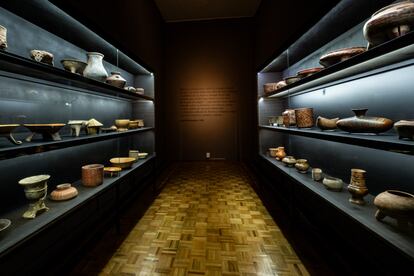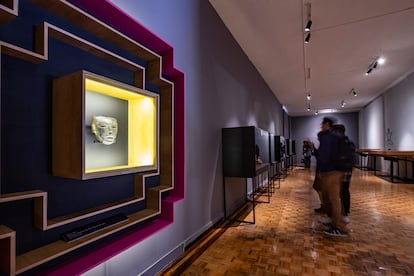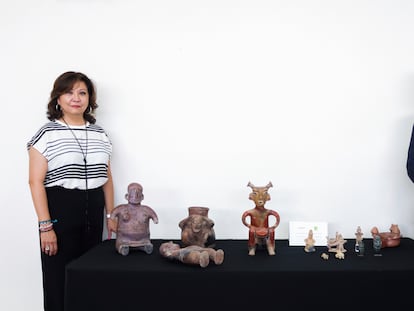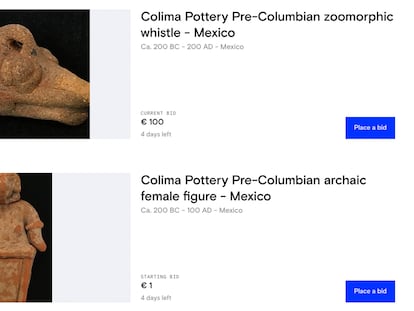Diplomats repatriate archeological treasures stolen from Mexico
An exhibition at the Foreign Ministry Museum in Mexico City is displaying more than 100 stolen pieces that have been recovered, thanks to intense work by the country’s diplomats


What can a diplomatic valise contain? Well, in the case of Mexico, it could be filled with treasure.
The Foreign Ministry Museum — housed in an old convent located in the historic center of the Mexican capital — is hosting an exhibition that, for the first time, brings together more than 150 archeological pieces that were recovered from abroad through intense diplomatic work. Many of the items were transported by Mexican diplomats, who repatriated them from the United States, Germany, France, or the Netherlands.
Among the looted treasures that have been returned to Mexican territory, there are some objects that are thousands of years old.
“This is just a taste — it’s just a very small portion of everything that has been recovered through various means, because we’re talking about more or less 15,000 pieces having been rescued,” explains Rafael Toriz, director of Visual Arts at Mexico’s Foreign Ministry.
The work done by Toriz and Rodrigo Fernández de Gortari — the curators of the exhibition — has been intense and would arouse envy in any archeology lover. These two men have rummaged through hundreds of boxes containing the thousands of pieces recovered from half the world. They’ve been safeguarded in the warehouses belonging to Mexico’s cultural institutions, under the care of officials who are determined to protect this heritage.
Some of the stories behind the pieces are almost implausible, worthy of a detective novel. Such is the case with the so-called Portal of the Underworld — or Chalcatzingo Monument 9 — which was undoubtedly the Mexican authorities’ most sought-after artefact from the Olmec civilization. The monument was stolen from Mexican territory more than 50 years ago. “For more than five decades, this piece was sought by the Mexican state, which, in 2006, proposed to offer the holders of the archaeological treasure ‘a fiberglass replica and a formal thank you,’ with the request that the sculpture of Olmec origin be returned to our country,” explained Jorge Islas López, Mexico’s consul general in New York City, in a book about the history of his country’s so-called “cultural diplomacy.”

The consul narrates how, in 1934, a storm hit Chalcatzingo, in the state of Morelos. It revealed a series of works carved in stone that experts had never seen, including the Olmec monument. The piece was stolen in the 1950s and, according to one of the witnesses to that looting (cited by the diplomat), it was transported in pieces and sold in the United States, in packaging that wouldn’t arouse the suspicions of the customs authorities.
Another Olmec sculpture — known as Earth Monster — ended up in the hands of a wealthy American family. Mexico’s Foreign Ministry believes that the work was purchased at the time for $12.5 million dollars. The monument — 3,000 years old and weighing more than one ton — was returned to the country after long negotiations with the US authorities and under the threat of prosecuting its owners for illegal trafficking. In the end, the collectors returned it. The relic is now exhibited in the Palace of Cortés, the structure that the conqueror built in the south-central Mexican city of Cuernavaca.
The exhibition at the Foreign Ministry Museum opens with a diplomatic suitcase on display, as a symbolic way for the authorities to honor the work done by dozens of diplomats to repatriate stolen works. Some pieces were also given up voluntarily by collectors, upon learning that they’re part of Mexican heritage.
Among the works on display is the Columnilla de Santa Rosa Xtampak, from Campeche, which is shown in the original packaging box in which it was recovered. In the exhibition, the curators explain that Xtampak means “old walls” in the Mayan language. The 58-pound piece is a fragment of a palace column that shows the Jaguar of the Underworld, a supernatural being that represented the sun. The work was delivered by an Austrian collector in 2022. Another one of the relics is a relief sculpture dedicated to the cult of the dead, called Tzompantli, from Chichén Itzá, which — in the Nahuatl language — means “altar of skulls.” Pikes were placed on these platforms, on which the heads of enemies were skewered. According to the curators of the exhibition, archeologists have found more than 500 skulls chiseled in high relief in this type of carving.
Also among the recovered pieces is a small face sculpted in stone, whose owner ordered a setting made in the shape of two snakes to wear it as a necklace… an eccentricity, without a doubt. But it’s so exotic and precious that the woman surely wore it with elegant pride. When observing the exhibition, visitors may be astonished to see that very rich people paid a fortune to possess looted works, which are part of an enormous heritage that hasn’t yet been fully recovered. Prized pieces from Mexico continue to be sold in auction houses in New York or Paris; they adorn the living rooms of millionaires and billionaires around the world.
“[Mexican citizens] know that these pieces have been returned to their place of origin — everyone knows that they’re here, thanks to the photos in the press — but they don’t know the path they took and that they’re part of our own history,” explains Fernández de Gortari, the exhibition’s curator.

Mexico has undertaken a major offensive on the political, diplomatic and legal front, which the administration of President Andrés Manuel López Obrador has turned into its main foreign cultural policy asset. The government’s strategy isn’t exempt from criticism, mainly due to the president’s incendiary discourse: he’s often heard accusing European nations of looting, or seen mobilizing the controversial National Guard to recover pre-Hispanic pieces. Still, the offensive has had relevant achievements, such as the recovery of more than 15,000 archeological pieces… or even Ralph Lauren’s decision to remove a collection of bags that copied the traditional Mexican serape (a colorful woolen shawl).
“Cultural diplomacy is a strategy that the Foreign Ministry utilizes to rescue and value culture as an agent of political and economic power. [Thanks to this], Mexico, once again, possesses these pieces that hold such great historical value,” Rafael Toriz affirms.
The exhibition — called A halo of splendor — will be open until March. Visitors will be able to enjoy Mexico’s archeological wealth and the exciting story of a handful of diplomats who dedicated themselves to repatriating their country’s history.
Sign up for our weekly newsletter to get more English-language news coverage from EL PAÍS USA Edition
Tu suscripción se está usando en otro dispositivo
¿Quieres añadir otro usuario a tu suscripción?
Si continúas leyendo en este dispositivo, no se podrá leer en el otro.
FlechaTu suscripción se está usando en otro dispositivo y solo puedes acceder a EL PAÍS desde un dispositivo a la vez.
Si quieres compartir tu cuenta, cambia tu suscripción a la modalidad Premium, así podrás añadir otro usuario. Cada uno accederá con su propia cuenta de email, lo que os permitirá personalizar vuestra experiencia en EL PAÍS.
¿Tienes una suscripción de empresa? Accede aquí para contratar más cuentas.
En el caso de no saber quién está usando tu cuenta, te recomendamos cambiar tu contraseña aquí.
Si decides continuar compartiendo tu cuenta, este mensaje se mostrará en tu dispositivo y en el de la otra persona que está usando tu cuenta de forma indefinida, afectando a tu experiencia de lectura. Puedes consultar aquí los términos y condiciones de la suscripción digital.
More information
Archived In
Últimas noticias
Luisa Neubauer, climate change activist: ‘Ecology shouldn’t be a punitive force, but a joyful and liberating one’
Trump followed CIA recommendation to hand power to Delcy Rodríguez due to risk that Machado would not control the army
The Motherwell painting that Franco wanted to hide from view
Mexico seeks to shore up its defenses following US incursion in Venezuela
Most viewed
- Alain Aspect, Nobel laureate in physics: ‘Einstein was so smart that he would have had to recognize quantum entanglement’
- Alvin Hellerstein, a 92-year-old judge appointed by Bill Clinton, to preside over Maduro’s trial in New York
- Cuba confirms death of 32 of its citizens in the US attack against Venezuela
- Gilles Lipovetsky: ‘If you want to live better and fall in love, take Prozac, don’t look to philosophy’
- Why oil has been at the center of Venezuela-US conflicts for decades










































